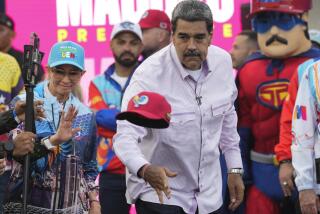Cooperation Training Boosts Colombia’s War on Drugs
BOGOTA, Colombia — By eavesdropping on wiretapped telephones, police investigators uncovered a full-service drug ring.
Gang members were trucking cocaine into this capital and loading it onto public transportation for the ride to the airport, where cooperative airline cleaning crews were sending it to the United States. Proceeds were laundered through wire transfers at foreign exchange houses.
Police turned the findings over to prosecutors, who ordered a further investigation to determine who was driving the trucks, sneaking the drugs onto planes and cashing the checks.
The problem, says a veteran prosecutor, is that the government lawyers forgot to prove these actions add up to a conspiracy to sell illegal drugs and reap the profits, which would constitute a major offense. “We have to get people to focus on the crime,” he said.
An error like that could have ruined months of police work. But in this case it did not.
Instead of making the mistake in court, the prosecutors goofed in a training exercise during a weeklong course this month designed to help them work better with police. The course is part of two little-known programs that accounted for only a fraction of $289 million in U.S. anti-narcotics aid to Colombia in 1999 but that U.S. and Colombian authorities say are as effective as several Black Hawk helicopters in the fight against drugs.
Over the past four years, the programs--one for prosecutors, another for police--have trained 16 regional narcotics investigation units. They also are helping develop special units to combat money laundering, corruption, human rights abuses and drug smuggling on the high seas. In 2000, Colombia’s three national police agencies will begin using a unified anti-narcotics curriculum that the programs developed.
Officials refused to talk about the programs for attribution, citing security concerns. However, several Colombians who have participated clearly were enthusiastic about the results.
“This is the first time we’ve done everything right,” a naval officer gushed, commenting on a joint U.S. Coast Guard and Colombian navy operation late last month shortly after one training session. “We got the drugs, we got the traffickers, and we got the evidence that the prosecutors need to convict.”
As a result of the November session attended by five Colombian prosecutors--part of the unit that specializes in maritime drug-trafficking cases--the U.S. Coast Guard changed its own checklist to make sure it provided evidence that the Colombians need to make a case.
So, law enforcement agencies were ready when the Colombians stopped a suspicious boat off their Caribbean coast. The captain had a map showing a route to Haiti with three clearly marked drop-off points. Coast Guard units investigated those spots and recovered packets of cocaine in each one.
A common smuggling technique uses small planes to drop packets of cocaine at prearranged places in the ocean, where speedboats pick up the bundles and take them to the next point along the route to the U.S. via Haiti.
The trial of the alleged traffickers arrested in November is still pending, but the naval officer said he plans to write a monograph on the operation as a textbook case of cooperation.
Cooperation has been one of the programs’ most important achievements, said a Colombian law enforcement official.
“We have been able to break down the rivalries among police agencies,” she said, “and help prosecutors understand what the different agencies do.”
Previously, she said, prosecutors tended to rely heavily on Colombia’s main spy agency.
“Before our training, programs were isolated and scattered,” she said. “Nobody worried much about training.” Now Colombians such as the naval officer are convinced that it makes a big difference.
More to Read
Sign up for Essential California
The most important California stories and recommendations in your inbox every morning.
You may occasionally receive promotional content from the Los Angeles Times.










